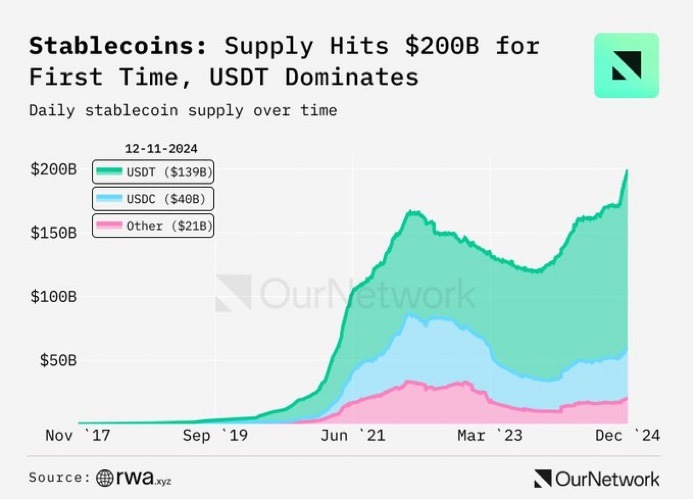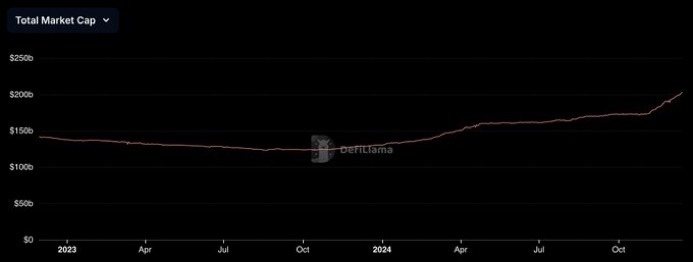FBI arrests Nigerian ‘tech queen’ Sapphire Egemasi in $1.3M heist targeting U.S. government
06/05/2025 - Updated On 06/17/2025
The stablecoin market cap has achieved a monumental milestone, surpassing the $200 billion mark. This unprecedented growth highlights the significant role stablecoins play in shaping the cryptocurrency landscape.
The stablecoin market cap now stands at $200 billion, with USDT leading the charge at $142.9 billion. Following closely is USDC at $42.3 billion, while DAI, USDe, FDUSD, and USDS collectively contribute to the dynamic ecosystem.
This remarkable achievement not only underscores stablecoins’ growing importance but also reflects the increasing adoption of crypto assets globally. For investors, regulators, and developers, the stablecoin market cap is more than just a number—it’s a signal of innovation, utility, and the evolving role of cryptocurrencies in mainstream finance.
At the heart of the stablecoin market cap’s meteoric rise are key players like Tether (USDT) and Circle (USDC). Together, these two giants dominate the stablecoin supply, accounting for over 90% of the market.
USDT’s Dominance:
With a staggering supply of $142.9 billion, Tether’s USDT remains the undisputed leader. Its widespread adoption is bolstered by its liquidity, reliability, and acceptance across global exchanges. Paolo Ardoino, Tether’s CEO, stated, “Our mission goes beyond stability. We aim to lead technological freedom by integrating blockchain and AI solutions into the financial ecosystem.”
USDC’s Strategic Growth:
Circle’s USDC holds the second spot with $42.3 billion in supply. Circle’s recent partnership with Binance aims to amplify USDC’s reach across blockchain networks and payment channels. Jeremy Allaire, CEO of Circle, remarked, “Strategic collaborations are crucial for driving global adoption and unlocking the true potential of stablecoins.”

Other players, including DAI ($4.5 billion), USDe ($6 billion), FDUSD ($1.9 billion), and USDS ($1.2 billion), continue to innovate, adding diversity to the stablecoin market cap.
The growth of the stablecoin market cap is not without challenges. Regulatory shifts are significantly impacting the industry, with Europe’s Markets in Crypto-Assets (MiCA) framework set to go into effect on December 30, 2024.
MiCA introduces stringent compliance requirements for stablecoin issuers, aiming to enhance transparency and protect investors. In response to MiCA’s mandates, Tether recently announced it would discontinue support for Euro Tether (EURT) due to reduced demand and the regulatory burden.
According to Paolo Ardoino, “Adapting to regulations is crucial for long-term stability and growth. We remain committed to ensuring our offerings align with the evolving regulatory landscape.”
MiCA is expected to set the tone for global stablecoin governance, influencing market players to prioritize compliance and innovation.
Partnerships are emerging as a cornerstone for growth in the stablecoin market cap. Circle’s collaboration with Binance exemplifies how alliances can expand adoption and enhance usability. By integrating USDC across multiple blockchain platforms, this partnership aims to make USDC a preferred choice for payments and remittances.

Meanwhile, Tether’s focus on integrating artificial intelligence with blockchain technology highlights its commitment to innovation. Tether’s dual emphasis on usability and decentralization is paving the way for practical applications of stablecoins in various sectors.
Ardoino emphasized, “Blockchain’s future lies in real-world utility. By combining AI and decentralized solutions, we aim to create scalable use cases that empower individuals and institutions.”
The stablecoin market cap journey to $200 billion is a testament to the sector’s resilience and innovation. However, as the market evolves, several factors will shape its future:
Regulatory Compliance:
MiCA and similar frameworks in other regions will demand greater transparency and accountability, ensuring stablecoins remain a trusted financial tool.
Technological Advancements:
Innovations like Tether’s integration of AI will redefine how stablecoins are used, unlocking new possibilities for decentralized finance (DeFi) and cross-border transactions.
Increased Adoption:
Strategic collaborations like Circle and Binance’s will enhance accessibility, making stablecoins an integral part of global payment systems.
Diversification of Stablecoins:
As newer stablecoins enter the market, competition will drive innovation, offering users a variety of options tailored to their needs.
The stablecoin market cap’s surge beyond $200 billion marks a significant milestone in the cryptocurrency sector. With USDT and USDC leading the charge, supported by regulatory adaptations and strategic alliances, the stablecoin market cap is poised for further growth.
As the industry continues to innovate, stablecoins are set to play an increasingly pivotal role in bridging traditional finance and decentralized ecosystems. With a focus on compliance, usability, and technology, the stablecoin market cap is not just a reflection of past achievements but a beacon of future potential.
The stablecoin market cap remains a key indicator of crypto’s transformative power. With the right balance of regulation, innovation, and adoption, it is set to redefine the financial landscape for years to come. Stay updated with the latest developments in the cryptocurrency industry through The BIT Gazette
Davidson Okechukwu is a passionate crypto journalist/writer and Web3 enthusiast, focusing on blockchain innovation, deFI, NFT ecosystems, and the societal impact of decentralized systems. His engaging style bridges the gap between technology and everyday understanding with a degree in Computer Science and various professional certifications from prestigious institutions. With over four years of experience in the crypto and DeFi space, Davidson combines his technical knowledge with a keen understanding of market dynamics. In addition to his work in cryptocurrency, he is a dedicated realtor and web management professional.